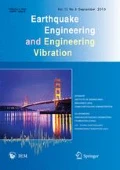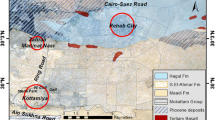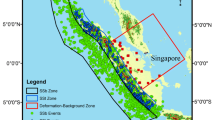Abstract
The seismic ground motion hazard for Nepal has been estimated using a probabilistic approach. A catalogue of earthquakes has been compiled for Nepal and the surrounding region (latitude 26° N and 31.7° N and longitude 79° E and 90° E) from 1255 to 2011. The distribution of catalogued earthquakes, together with available geological and tectonic information were used to delineate twenty-three seismic source zones in Nepal and the surrounding region. By using the seismic source information and probabilistic earthquake hazard parameters in conjunction with a selected ground motion prediction relationship, peak ground accelerations (PGAs) have been calculated at bedrock level with 63%, 10%, and 2% probability of exceedance in 50 years. The estimated PGA values are in the range of 0.07–0.16 g, 0.21–0.62 g, and 0.38–1.1 g for 63%, 10%, and 2% probability of exceedance in 50 years, respectively. The resulting ground motion maps show different characteristics of PGA distribution, i.e., high hazard in the far-western and eastern sections, and low hazard in southern Nepal. The quantified PGA values at bedrock level provide information for microzonation studies in different parts of the country.
Similar content being viewed by others
References
Ader T, Avouac JP, Zeng JL, Caen HL, Bollinger L, Galetzka J, Genrich J, Thomas M, Chanard K, Sapkota SN, Rajaure S, Shrestha P, Ding L and Flouzat M (2012), “Convergence Rate across the Nepal Himalaya and Interseismic Coupling on the Main Himalayan Thrust: Implications for Seismic Hazard,” Journal of Geophysical Research, 117: B04403, doi:10.1029/2011JB009071.
Amatya KM and Gnawali BN (1994), Geological Map of Nepal, (1:1000000 Scale), Department of Mines and Geology, Kathmandu, ICIMOD, CDG, UNEP.
Ambraseys N and Douglas J (2004), “Magnitude Calibration of North Indian Earthquakes,” Geophysical Journal International, 159(1): 165–206.
Armijo R, Tapponnier P, Mercier JL and Tonglin H (1986), “Quaternary Extension in Southern Tibet,” Journal of Geophysical Research, 91: 13803–13872.
Avouac JP (2003), “Mountain Building, Erosion, and the Seismic Cycle in the Nepal Himalaya,” Advances in Geophysics, 46: doi: 10.1016/S0065-2687(03)46001-9.
Bettinelli P, Avouac JP, Flouzat M, Jouanne F, Bollinger L, Willis P and Chitrakar G (2006), “Plate Motion of India and Interseismic Strain in the Nepal Himalaya from GPS and DORIS Measurements,” Journal of Geodesy, 80: 567–589.
Bilham R (1995), “Location and Magnitude of the 1833 Nepal Earthquake and Its Relation to the Rupture Zones of Contiguous Great Himalayan Earthquakes,” Current Science, 69: 101–128.
Bilham R, Larson K, Freymueller J and Project Idylhim members (1997), “GPS Measurements of Present-day Convergence across the Nepal Himalaya,” Nature, 386: 61–64.
Bollinger L, Avouac JP, Cattin R and Pandey MR (2004), “Stress Buildup in the Himalaya,” Journal of Geophysical Research, 109: doi: 10.129/2003JB002911.
Cattin R and Avouac JP (2000), “Modeling Mountain Building and the Seismic Cycle in the Himalaya of Nepal,” Journal of Geophysical Research, 105: 13389–13407.
Chandra U (1992), “Seismotectonics of Himalaya,” Current Science, 62: 40–71.
Chen WP and Molnar P (1977), “Seismic Moments of Major Earthquakes and the Average Rate of Slip in Central Asia,” Journal of Geophysical Research, 82(20): 2945–2969.
China Earthquake Administration (CEA) (2005), Training Material on Seismic Hazard Analysis for Engineering Sites (GB17741-2005). (in Chinese).
Cornell CA (1968), “Engineering Seismic Risk Analysis,” Bulletin of the Seismological Society of America, 58: 1583–1606.
Dasgupta S, Mukhopadhaya M and Nandy DR (1987), “Active Transverse Features of the Central Portion of the Himalaya,” Tectonophysics, 136: 255–264.
DeCelles PG, Gehrels GE, Quade J, Ojha TP, Kapp PA and Upreti BN (1998), “Neogene Foreland Basin Deposits, Erosional Unroofing, and the Kinematic History of the Himalayan Fold-thrust Belt, Western Nepal,” Geological Society of America Bulletin, 110: 2–21.
DeCelles PG, Robinson DM, Quade J, Ojha TP, Garzione CN, Copeland P and Upreti BN (2001), “Stratigraphy, Structure, and Tectonic Evolution of the Himalayan Fold-thrust Belt in Western Nepal,” Tectonics, 20: 487–509.
Douglas J (2003), “Earthquake Ground Motion Estimation Using Strong-motion Records: a Review of Equations for the Estimation of Peak Ground Acceleration and Response Spectral Ordinates,” Earth-Science Reviews, 61: 43–104.
Gansser A (1964), Geology of the Himalayas, Interscience Publisher, New York, pp. 289.
Garzione CN, DeCelles PG, Hodkinson DG, Ojha TP and Upreti BN (2003), “East-west Extension and Miocene Environmental Change in the Southern Tibetan Plateau: Thakkhola Graben, central Nepal,” Geological Society of America Bulletin, 115(1): 3–20.
Gehrels GE, DeCelles PG, Ojha TP and Upreti BN (2006), “Geologic and U-Pb Geochronologic Evidence for early Paleozoic Tectonism in the Kathmandu Thrust Sheet, Central Nepal Himalaya,” Geological Society of America Bulletin, 118: 185–198.
Gelfand I, Guberman Sh, Izvekova M, Keilis-Borok V and Rantsman EYa (1972), “Criteria of High Seismicity, Determined by Pattern Recognition,” Tectonophysics, 13: 415–422.
Gutenberg B and Richter CF (1944), “Frequency of earthquakes in California,” Bulletin of the Seismological Society of America, 34: 185–188.
Gutenberg B and Richter CF (1954), Seismicity of the Earth and Associated phenomena, 2nd ed, Princeton Univ. Press, pp. 310.
Gutenberg B and Richter CR (1956), “Earthquake Magnitude, Intensity, Energy and Acceleration,” Bulletin of the Seismological Society of America, 46: 105–145.
Hanks TC and Kanamori H (1994), “A Moment Magnitude Scale,” Journal of Geophysical Research, 84: 2348–2350.
Hodges KV (2000), “Tectonics of the Himalaya and Southern Tibet from Two Perspectives,” Geological Society of America Bulletin, 112: 324–350.
International Seismological Centre (ISC), Bulletin, Thatcham, UK, (http://www.isc.ac.uk/Bull).
Jouanne F, Mugnier J, Gamond J, Le Fort P, Pandey MR, Bollinger L, Flouzat M and Avouac JP (2004), “Current shortening across the Himalayas of Nepal,” Geophysical Journal International, 157: 1–14.
Jouanne F, Mugnier J, Pandey M, Gamond J, Le Fort P, Serrurier L, Vigny C and Avouac JP (1999), “Oblique Convergence in the Himalayas of Western Nepal Deduced from Preliminary Results of GPS Measurements,” Geophysical Research Letters, 26(13): 1933–1936.
Kramer SL (1996), Geotechnical Earthquake Engineering, Prentice Hall International Series in Civil Engineering and Engineering Mechanics, Washington, 106–129.
Larson KM, Bürgmann R, Bilham R and Freymueller JT (1999), “Kinematics of the India-Eurasia Collision Zone from GPS Measurements,” Journal of Geophysical Research, 104: 1077–1093.
Lavé J and Avouac JP (2000), “Active Folding of Fluvial Terraces across the Siwaliks Hills, Himalayas of Central Nepal,” Journal of Geophysical Research, 105: 5735–5770.
Lee WHK, Wu FT and Jacobsen C (1976), “A Catalog of Historical Earthquakes in China,” Bulletin of the Seismological Society of America, 66: 2003–2016.
Li W and Li S (2010), “Generation Methodology of Isolines of Earthquake Ground Motion,” Earthquake Engineering and Engineering Vibration, 9(4): 473–480.
Li W, Li S, Lu J and Zhao Z (2011), “An Improved Method for Fitting Ground Motion Attenuation Relationship,” Applied Mechanics and Materials, 90–93: 1639–1643.
Liu R, Chen Y, Ren X, Xu Z, Sun L, Yang H, Liang J and Ren K (2007), “Comparison between Different Earthquake Magnitudes Determined by China Seismograph Networks,” Acta Seismologica Sinica, 29: 467–476. (in Chinese).
Mahajan AK, Thakur VC, Sharma ML and Chauhan M (2010), “Probabilistic Seismic Hazard Map of NW Himalaya and Its Adjoining Area, India,” Natural Hazards, 53: 443–457.
McGuire RK (1976), FORTRAN Computer Program for Seismic Risk Analysis, U.S. Geological Survey Open-File Report, 76-67.
McGuire RK (1993), “Computations of Seismic Hazard,” Annali Di Geofisica, XXXVI: 3–4.
McGuire RK (1995), “Probabilistic Seismic Hazard Analysis and Design Earthquakes: Closing the Loop,” Bulletin of the Seismological Society of America, 85: 1275–1284.
McGuire RK and Arabasz WJ (2000), “An Introduction to Probabilistic Seismic Hazard Analysis,” Geotechnical and Environmental Geophysics I: Review and Tutorial.
Nakata T (1972), Geomorphic History and Crustal Movements of Foothills of the Himalaya, Science Report, 22: 39–177, Tohoku University.
Nakata T (1982), “A Photogrammetric Study on Active faults in the Nepal Himalayas,” Journal of Nepal Geological Society, 2: 67–80.
Nakata T (1989), “Active Faults of the Himalaya of India and Nepal,” Special Paper-Geological Society of America, 232: 243–264.
Nakata T, Iwata S, Yamanaka H, Yagi H and Maemoku H (1984), “Tectonic Landforms of Several Active Faults in the Western Nepal Himalayas,” Journal of Nepal Geological Society, 4: 177–200.
Nath SK and Thingbaijam KKS (2012), “Probabilistic Seismic Hazard Assessment of India,” Seismological Research Letters, 83(1): 135–149.
National Earthquake Information Center (NEIC), United States Geological Survey, U.S.A, (http://neic.usgs.gov).
National Seismological Centre (NSC), Department of Mines and Geology, Nepal, (http://seismonepal.gov.np).
Nelson KD, Zhao W, Brown LD, Kuo J, Che J, Liu X, Klemperer SL, Makovsky Y, Meissner R, Mechie J, Kind R, Wenzel F, Ni J, Nabelek J, Leshou C, Tan H, Wei W, Jones AG, Booker J, Unsworth M, Kidd WSF, Hauck M, Alsdorf D, Ross A, Cogan M, Wu C, Sandvol E and Edward M (1996), “Partially Molten Middle Crust Beneath Southern Tibet: Synthesis of Project-INDEPTH results,” Science, 276: 1684–1686.
Oldham T (1883), “A Catalogue of Indian Earthquake from Earliest Time to the End 1869,” Memoirs of the Geological Survey of India, 19: 163–215.
Pandey MR (1983), Seismicity of Nepal (A Preliminary Study), His Majestry’s Government of Nepal, Ministry of Industry, Department of Mines and Geology, Seismological Laboratory, Kathmandu, Nepal, Internal Report, 3–17.
Pandey MR, Chitrakar GR, Kafle B, Sapkota SN, Rajaure S and Gautam UP (2002), Seismic Hazard Map of Nepal, National Seismological Centre, Kathmandu, Nepal, 1–8.
Pandey MR and Molnar P (1988), “The Distribution of Intensity of the Bihar-Nepal Earthquake of 15 January 1934 and Bounds on the Extent of the Rupture Zone,” Journal of Nepal Geological Society, 5(1): 22–44.
Pandey MR, Tandukar RP, Avouac JP, Lavé J and Massot JP (1995), “Interseismic Strain Accumulation on the Himalayan Crustal Ramp (Nepal),” Geophysical Research Letters, 22(7): 751–754.
Pandey MR, Tandukar RP, Avouac JP, Vergne J and Héritier Th (1999), “Seismotectonics of the Nepal Himalaya from a Local Seismic Network,” Journal of Asian Earth Sciences, 17: 703–712.
Seeber L and Armbruster JG (1981), “Great Detachment Earthquakes along the Himalayan Arc and Long-term Forecasting,” Earthquake Prediction, the American Geophysical Union, Maurice Ewing Series, 4: 259–277.
Srivastava NN and Ramachandram K (1985), “A New catalogue of Earthquakes for Peninsular India during 1839–1900,” Mausam, 36(30): 351–358.
Taylor MH and Yin A (2009), “Active structures of the Himalayan-Tibetan Orogen and Their Relationships to Earthquake Distribution, Contemporary Strain Field, and Cenozoic Volcanism,” Geosphere, 5(3): 199–214; doi: 10.1130/GES00217.1.
Thapa DR (2008), “Seismic Hazard and Ground Motion in Nepal,” Diploma Dissertation, unpublished, The Abdus Salam International Centre for Theoretical Physics, Trieste, Italy.
Thapa DR and Wang G (2010), “Spatial Distribution of Seismicity and Possible Disaster in the Nepal Himalaya and Its Surrounding Region,” Proceedings of the 9th International Conference on Civil and Environmental Engineering, Advances in Civil and Environmental Engineering, China Architecture and Building Press, November 1–3, 2010, Dalian, P.R. China. Paper number 2.53.
Upreti BN (1999), “An Overview of the Statigraphy and tectonics of the Nepal Himalaya,” Journal of Asian Earth Sciences, 17: 577–606.
Upreti BN and Le Fort P (1999), “Lesser Himalayan Crystalline Nappes of Nepal: Problems of Their Origin,” Special Paper — Geological Society of America, 328: 225–238.
Upreti BN, Nakata T, Kumahara Y, Yagi H, Okumura K, Rockwell TK, Virdi NS and Maemoku H (2000), “The Latest Active Faulting in Southeast Nepal,” Proceedings of the Hokudan International Symposium and School on Active Faulting, January 17–26, 2000, Japan, 533–536.
Wang S, Wang J, Yu Y, Wu Q, Gao A and Gao M (2010), “The Empirical Relationship between M L and M S Based on Bulletin of Seismological Observations of Chinese Stations,” Earthquake Research in China, 26(1): 14–22. (in Chinese).
Yin A (2006), “Cenozoic Tectonic Evolution of the Himalayan Orogen as Constrained by Along-strike Variation of Structural Geometry, Exhumation History, and Foreland Sedimentation,” Earth-Science Reviews, 76: 1–131.
Zhao W, Nelson KD, Che J, Quo J, Lu D, Wu C and Liu X (1993), “Deep Seismic Reflection Evidence for Continental Underthrusting beneath Southern Tibet,” Nature, 366: 555–559.
Author information
Authors and Affiliations
Corresponding author
Additional information
Supported by: National Natural Science Foundation of China under Grant No. 51121005 and Grant No. 51378092
Rights and permissions
About this article
Cite this article
Ram, T.D., Wang, G. Probabilistic seismic hazard analysis in Nepal. Earthq. Eng. Eng. Vib. 12, 577–586 (2013). https://doi.org/10.1007/s11803-013-0191-z
Received:
Accepted:
Published:
Issue Date:
DOI: https://doi.org/10.1007/s11803-013-0191-z




